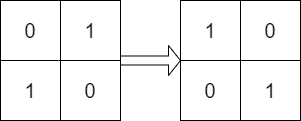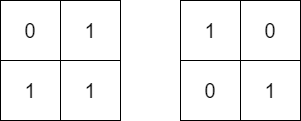Given two n x n binary matrices mat and target, return true if it is possible to make mat equal to target by rotating mat in 90-degree increments, or false otherwise.
Example 1:
Input: mat = [[0,1],[1,0]], target = [[1,0],[0,1]] Output: true Explanation: We can rotate mat 90 degrees clockwise to make mat equal target.
Example 2:
Input: mat = [[0,1],[1,1]], target = [[1,0],[0,1]] Output: false Explanation: It is impossible to make mat equal to target by rotating mat.
Example 3:
Input: mat = [[0,0,0],[0,1,0],[1,1,1]], target = [[1,1,1],[0,1,0],[0,0,0]] Output: true Explanation: We can rotate mat 90 degrees clockwise two times to make mat equal target.
Constraints:
n == mat.length == target.lengthn == mat[i].length == target[i].length1 <= n <= 10mat[i][j]andtarget[i][j]are either0or1.
Companies:
Amazon
Related Topics:
Array
Similar Questions:
// OJ: https://leetcode.com/problems/determine-whether-matrix-can-be-obtained-by-rotation/
// Author: github.com/lzl124631x
// Time: O(N^2)
// Space: O(1)
class Solution {
void rotate(vector<vector<int>> &A) {
int N = A.size();
for (int i = 0; i < N / 2; ++i) {
for (int j = i; j < N - i - 1; ++j) {
int tmp = A[i][j];
A[i][j] = A[j][N - i - 1];
A[j][N - i - 1] = A[N - i - 1][N - j - 1];
A[N - i - 1][N - j - 1] = A[N - j - 1][i];
A[N - j - 1][i] = tmp;
}
}
}
public:
bool findRotation(vector<vector<int>>& A, vector<vector<int>>& B) {
if (A == B) return true;
for (int i = 0; i < 3; ++i) {
rotate(A);
if (A == B) return true;
}
return false;
}
};

